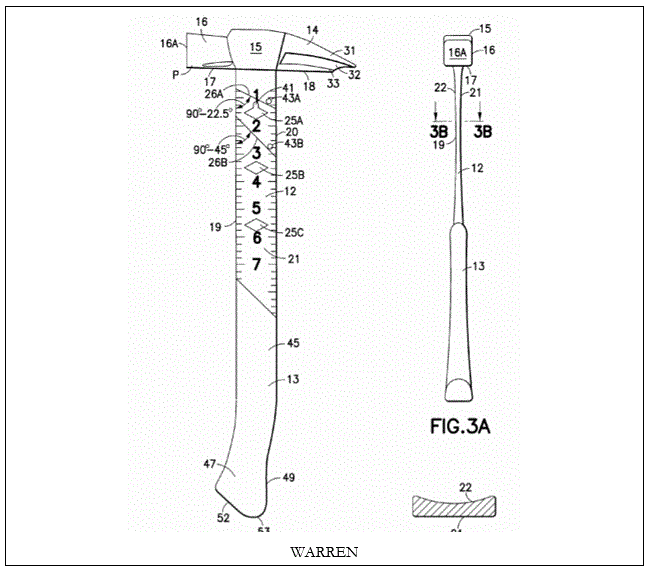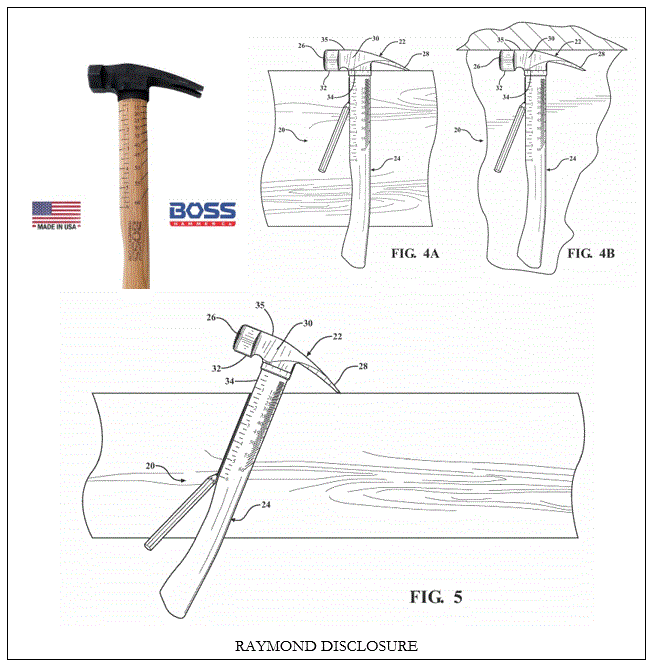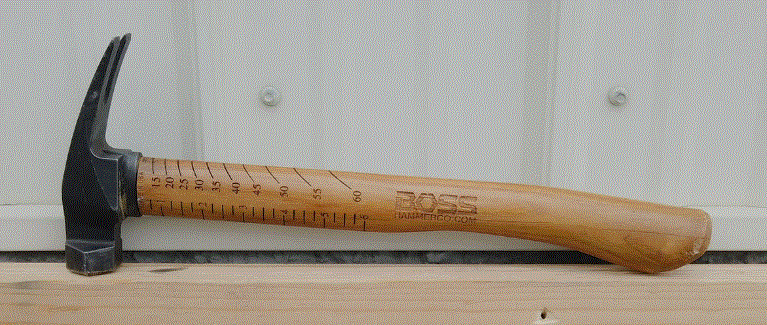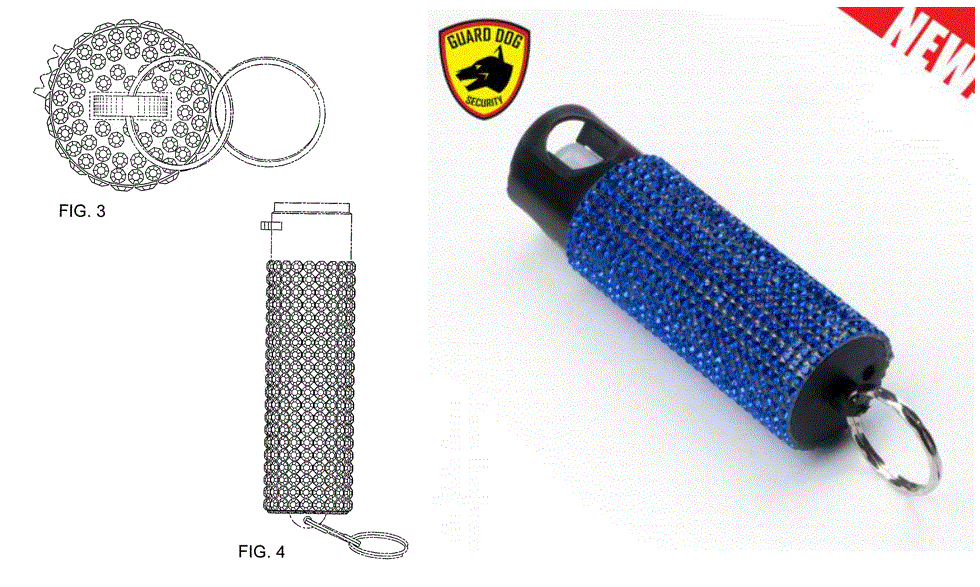At the University of Missouri, my patent law class is practice based – with students drafting claims, rejecting claims, responding to office actions, and participating in a patent law moot court competition. The class is pretty much fully packed. Still, I also give them a short final exam to ensure sure that they have learned the basics. This year’s exam is based upon an actual pending patent application for the Boss Hammer. Note – I played with the actual facts and claims a bit to make it all more straightforward.
= = = =
Introduction: Daniel Raymond is the inventor of the “Boss Hammer” shown below. The hammer works as a conventional claw-hammer that might be used by a carpenter or house framer, but also has several secondary functions. You can see the ruler being used in the drawings below. The head of the hammer is slightly wider than the handle that allows it to rest atop a board (FIG 4A) and is arranged so that the handle extends out at a right-angle when the head is resting on the board. The head of the hammer is standard width (here 1-inch) so that it can form part of the measurement (FIG 4B). The hammer also includes a set of angle marks calibrated with the claw end (FIG 5). This replaces a carpenter square so that you wouldn’t need to carry so many tools.
Raymond’s patent application claims a March 2019 effective filing date and includes the description and drawings above. The application is currently pending before the USPTO with the following claims:
1. A hammer, comprising: a head; and a handle extending from said head;
wherein said head includes (a) a nail-striking section having a base surface and (b) a nail-pulling section having a pair of claws, each claw having an end;
wherein the claw ends share a common plane with the base surface of the nail-striking section; and wherein no other portions of the claws share a common plane with the base surface of the nail-striking section;
wherein at least a portion of said handle extends linearly and perpendicularly to said common plane for allowing a user to draw a straight line which is perpendicular to the common plane.
2. The hammer as set forth in claim 1 wherein said handle further includes angle indicia which indicates angles relative to said ends of said claws for allowing a user to draw a straight line which is non-perpendicular to the common plane.
[Note: I did not provide the students with this, but you can read Raymond’s published patent application here: Raymond Published App (Patent Center link). Likewise with the prior art: Warren Patent Prior Art].
Prior to filing the patent application, Raymond formed a new company (Boss Hammer Co.) and assigned his rights to the patent application to the new company.
One key prior art reference has been identified by the USPTO Examiner: U.S. Patent No. 7,621,503 (“Warren”). That patent has now expired, but the Patent Examiner identified it as prior art because Warren’s patent application was filed in 2005 and the patent issued in 2009.

= = = = =
Question 1. Is Raymond’s claim 2 directed toward eligible subject matter?
Question 2. Provide a concise argument why the USPTO should reject claim 1 as indefinite.
Question 3. Raymond is concerned that his pre-filing assignment of rights (discussed above) might block him from receiving a patent. In particular, the transfer document is labelled a “sale of patent rights” and recite $1 as consideration. Will the assignment of rights cause his company problems under Section 102?
Question 4. Should Warren bar Raymond from obtaining a patent?
Question 5. Higher-end hammer-heads are often made of titanium and it is well known in the industry how to form hammer-heads out of the metal. In his patent application, Raymond only disclosed Steel as a material for the hammer head. Raymond has suggested to his attorney that he would like to add a claim limitation directed to a titanium head. Raymond correctly notes that, after reading his application, someone skilled in the art would be able to make-and-use a titanium version of his invention. Can he amend the claims to add the titanium-head element? (Consider only written description and enablement requirements).
Question 6. It is now 2022: Raymond obtained a patent covering claim 1 in 2021. Later that year, IKEA began selling a similar hammer for its customers to use when assembling furniture.[1] The key difference between what Raymond sells and IKEA’s is that IKEA’s hammer-head is rubber-coated metal. In addition, IKEA sells the hammer unassembled with instructions for assembly. (It comes in two separate pieces –head and handle). Will Raymond be able to show that IKEA infringes?
[1] IKEA sells its furniture unassembled, and it is a notoriously laborious process to assemble some items.
= = = = =
The hammer here looks pretty cool and would be a great holiday gift for your patent attorney friends. Wrap it in the drawings from the patent application.






